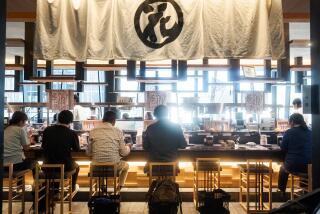Warming up a cold front
- Share via
The refrigerator stuck out like a sore thumb in our newly remodeled kitchen. It was a hand-me-down from a friend who’d upgraded to a SubZero, and my husband hated the thing. Ten years old and counting, it had an almond finish and a particularly ugly beverage dispenser mounted on the front.
And there it sat, between a 19th century Chinese lacquered vegetable cabinet and our sleek double Gaggenau oven finished in smoky glass. The cabinets were painted blue-black with matte stainless handles. The stove hood was stainless too. And when you looked toward the open kitchen from the dining or living room, that ugly refrigerator was practically center stage.
I had to do something. We’d spent hours and hours trolling through the refrigerator department at Serv-Well Appliances, Expo Design Center and Sears looking for something with a good design that wouldn’t break our budget. Except for the straightforward design of SubZeros, this is not a particularly felicitous moment in the annals of refrigerator design. I just couldn’t bring myself to buy any of the models on offer with their bulbous plastic insides or chunky handles. The fact that I didn’t want a beverage dispenser limited the choices too. I didn’t want a behemoth either.
I finally gave up.
Back to the reality. Because the fridge wasn’t pristine or new, I felt free to have my way with it. My friend Pat McGann of Pat McGann Gallery on La Cienega Boulevard had taken an old sideboard and transformed it by collaging torn pieces of Japanese silk-screen stencils she’d found at the flea market.
I decided to do something similar and headed off to Hiromi Paper International at Bergamot Station in Santa Monica to see if it had some heavy handmade paper that might work. This shop is on my all-star list of shopping in L.A. Owner Hiromi Katayama travels all over Japan searching out handmade papers. She supplies museum curators, book restorers, artists and anyone who loves beautiful paper.
In about five minutes, I zeroed in on some heavy blue-gray sheets of paper from Nepal, I think. I’ve got a pretty good eye for color and when I got back, it turned out the color was a perfect match against the ovens.
I’d never done something like this before, but plunged right in. First I dismantled the beverage dispenser, which leaked anyway, and covered the hole with a piece of cardboard. Then I painted on some PVC glue and, working from the top down, smoothed the paper with my hands. When I came to the end of a sheet, I left the last inch of the deckle edge free so that I could glue it down over the new sheet. The deckle edge feathered right into the sheet so the joins weren’t too obvious. When I finished, I gave the paper a coat of matte acrylic medium to protect it from wet hands. And as a final touch, I painted the handles the same blue-black as the cabinets.
Total cost, about $50. Now the fridge is not the first thing you notice when you walk into the kitchen. It disappears into the ensemble of appliances. I’m not expecting this fix to last forever, just until I find the perfect refrigerator, which will probably be sometime in the next design cycle when bulbous has given way to something more discreet.
After a year, the paper is starting to fade just a little at the bottom where the sun hits it. When I get around to it, I’ll just mix up some acrylic in a similar shade and give it a light wash.
S. Irene Virbila is The Times’ restaurant critic.
More to Read
Eat your way across L.A.
Get our weekly Tasting Notes newsletter for reviews, news and more.
You may occasionally receive promotional content from the Los Angeles Times.










